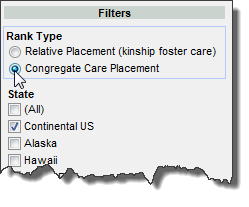Background
My older brother is a founder of The National Coalition for Child Protection Reform (NCCPR), an organization working to help America’s vulnerable children by changing public policy concerning child abuse, foster care, and family preservation.
While NCCPR believes that far too many children are in foster care there are some cases where children really do need to be placed in substitute care. In those cases, not all “placement settings” are created equal. In the overwhelming majority of cases, the least detrimental alternative, the one most likely to “cushion the blow” of foster care placement is placement with a relative, typically a grandparent. This is commonly known as kinship foster care.
At the other extreme, the worst form of care is “congregate care” – a group home or an institution – where the child is denied any family at all.
Every year, the federal government asks the states for a “snapshot” of how many children they have in these and other “placement settings” on September 30, the last day of the federal fiscal year. But the federal government publishes only the national totals. Using the federal Freedom of Information Act, NCCPR has obtained the state-by-state totals for the most recent year available, 2009, and my brother asked if I could present this information in a visual, interactive format (click here to explore the visualization.)
Goals
One of our goals was to show which states are the best in providing kinship care and which are the worst in overusing congregate care.
The chart below is map showing the proportion of children in kinship care.
It’s easy to glean that states such as Florida, Washington, and New Jersey excel in kinship placement while Tennessee, Virginia, and South Carolina lag (note that Hawaii, not shown, ranks first in this category).
By hovering over a circle you can see data for a particular state, in this case, Florida.
And clicking on a circle (or circles) presents a more details breakdown of information.
The dashboard also provides a simple mechanism that allows the viewer to switch gears and focus instead on congregate care.
By clicking the Rank Type filter (below)
The map display changes and we can see that Wyoming, Colorado, and Rhode Island are the worst culprits and that Washington, Oregon, and New Mexico should be chastised the least.
Ranking
My brother tells me that journalists covering this topic love to know where certain states rank with respect to kinship care and congregate care. By clicking the Placement Rankings tab at the top of the dashboard we see a list of 52 “states” (50 states, plus District of Columbia and Puerto Rico) ranked by Relative Placement (kinship foster care).
By clicking the “Group Home, Institution” column and clicking the Sort button at the bottom of the screen
We can see Congregate Care rankings, as shown below.
I encourage you to explore the interactive visualization yourself (click here) and also to visit the NCCPR web site as I’m very proud of what my brother is doing.














